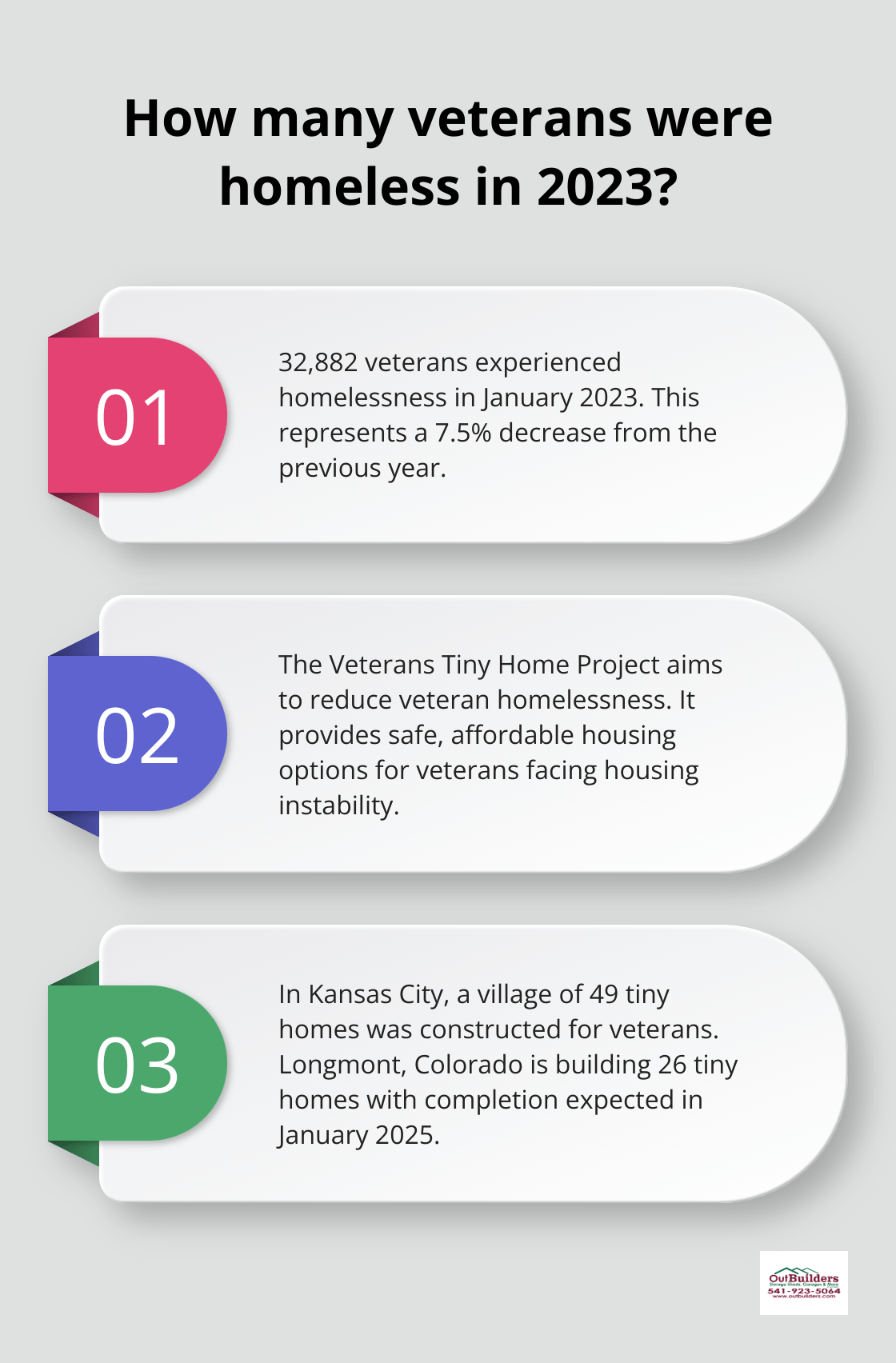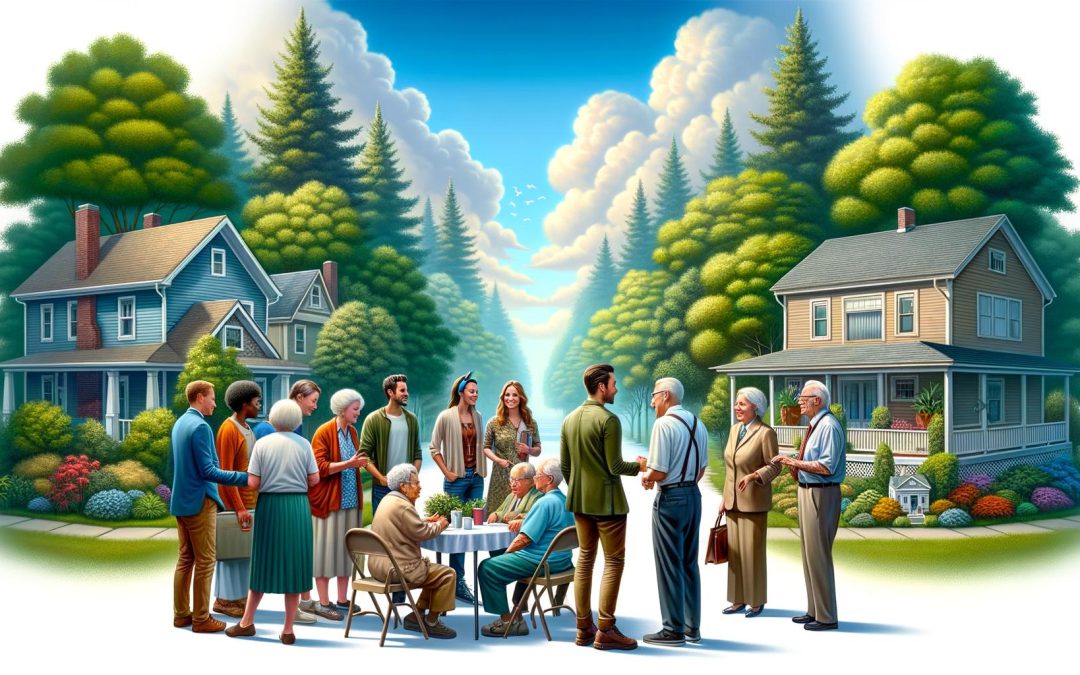At Outbuilders, we’re excited to explore the Veterans Tiny Home Project, an innovative initiative addressing housing challenges for our nation’s heroes.
This project offers affordable, efficient living spaces tailored to veterans’ unique needs, fostering a sense of community and independence.
We’ll dive into the benefits, design features, and impact of these tiny homes, showcasing how they’re changing lives and supporting our veterans.
What is the Veterans Tiny Home Project?
The Veterans Tiny Home Project represents a revolutionary approach to addressing housing challenges for our nation’s heroes. This initiative has gained significant momentum across the United States, offering affordable and sustainable housing solutions for veterans who face homelessness or housing instability.
A Nationwide Movement
This project transcends the boundaries of a single organization or location. It has evolved into a nationwide movement with diverse organizations and communities participating. For example:
- The Veterans Community Project in Kansas City constructed a village of 49 tiny homes for veterans.
- In Longmont, Colorado, 26 tiny homes are under construction (with a target completion date of January 2025).
Goals and Impact
The Veterans Tiny Home Project primarily aims to eradicate veteran homelessness. The U.S. Department of Housing and Urban Development reports that 32,882 veterans experienced homelessness in January 2023, a decrease of 7.5% from the previous year. This project strives to significantly reduce this number by providing safe, affordable housing options.

The project’s scope extends beyond mere shelter provision. It seeks to foster a sense of community among veterans. Many of these tiny home villages incorporate communal spaces and support services, creating an environment that promotes mutual support and camaraderie.
Partnerships Driving Success
The success of the Veterans Tiny Home Project hinges on robust partnerships and collaborations. Government agencies, non-profit organizations, and private companies all play vital roles in this initiative.
Key partnerships include:
- The U.S. Department of Veterans Affairs collaborates with local communities to support these initiatives.
- The Home Depot Foundation contributes significantly by providing grants for tiny home construction.
- Companies in the construction industry, such as Hensel Phelps, organize volunteer events to build tiny homes for unhoused veterans. Their Veterans Network (VNet) mobilized 23 employees to contribute labor and expertise to a tiny home project in Colorado.
These partnerships not only provide essential funding and labor but also raise awareness about veteran homelessness and the effectiveness of tiny homes as a solution. They exemplify how collective efforts can create meaningful change for our veterans.
Design Considerations
The design of these tiny homes prioritizes functionality and comfort. Architects and builders work to create space-efficient layouts that maximize every square foot. Some common design features include:
- Multi-purpose furniture (e.g., beds that convert to desks)
- Compact, energy-efficient appliances
- Clever storage solutions (such as under-stair storage or built-in shelving)
Accessibility remains a key consideration, with many homes incorporating features like wheelchair ramps and wider doorways to accommodate veterans with disabilities.
As we explore the benefits of tiny homes for veterans in the next section, we’ll see how these design elements contribute to improved quality of life and independence for our nation’s heroes.
Why Tiny Homes Work for Veterans
Cost-Effective Housing
Tiny homes offer a practical and effective housing solution for veterans, addressing multiple challenges they often face. The affordability of tiny homes transforms lives for veterans struggling with housing costs. The National Low Income Housing Coalition reports the average cost of a two-bedroom apartment in the U.S. at $1,295 per month. Tiny homes significantly reduce this financial burden. The Veterans Community Project in Kansas City provides tiny homes to veterans at no cost, with an 85 percent success rate in transitioning formerly homeless veterans to permanent housing.

For veterans on fixed incomes or disability benefits, this cost reduction can mean the difference between homelessness and stable housing. The money saved on housing allows veterans to redirect funds to other essential needs like healthcare, education, or savings.
Simplified Living and Reduced Expenses
Tiny homes simplify veterans’ lives by reducing maintenance needs and utility costs. The average American home measures about 2,300 square feet, while tiny homes typically range from 100 to 400 square feet. This size difference translates to lower heating, cooling, and electricity bills.
Veterans often struggle with physical or mental health issues that can make home maintenance challenging. Tiny homes require less upkeep, allowing veterans to focus on their recovery and personal growth rather than property management.
Building Supportive Communities
Many tiny home projects for veterans create communities, fostering a sense of belonging and mutual support. The Veterans Village in Port Jervis, New York, plans to build tiny homes for veterans, with homes built by Orange/Ulster BOCES students to be delivered in the near future. This setup encourages interaction and peer support, which can prove invaluable for veterans dealing with PTSD or readjusting to civilian life.
These communities often integrate support services on-site. For instance, the Veterans Community Project in Kansas City provides access to mental health services, job training, and legal assistance within the tiny home village. This holistic approach addresses multiple aspects of veterans’ needs, increasing their chances of long-term stability and success.
Customization and Accessibility
Tiny homes for veterans often feature customizable designs to meet individual needs. This flexibility allows for the incorporation of accessibility features (such as wheelchair ramps or wider doorways) for veterans with disabilities. The ability to personalize their living space can significantly enhance a veteran’s sense of ownership and comfort.
Environmental Benefits
The smaller footprint of tiny homes aligns with environmentally conscious living. These homes typically use fewer resources to build and maintain, resulting in reduced energy consumption and a lower carbon footprint. For veterans who value sustainability, tiny homes offer an opportunity to live in alignment with their environmental values while enjoying the benefits of homeownership.
As we explore the design and features of veteran tiny homes in the next section, we’ll see how these elements come together to create functional and comfortable living spaces tailored to the unique needs of our nation’s heroes.
How Are Veteran Tiny Homes Designed?
Maximizing Space Efficiency
Veteran tiny homes typically range from 240 to 320 square feet, which requires ingenious space utilization. Architects use multi-functional furniture and clever storage solutions to optimize limited space. The Veterans Community Project in Kansas City incorporates murphy beds that transform into desks during the day. Built-in shelving units and under-stair storage compartments provide ample room for personal belongings without cluttering the living area.
Prioritizing Accessibility
Accessibility stands at the forefront of veteran tiny home design. Many veterans face mobility challenges, so these homes often include features such as:
- Zero-step entries
- Wider doorways (at least 36 inches)
- Roll-in showers with grab bars
- Lower countertops and cabinets

The Veterans Village in Port Jervis, New York, ensures all their tiny homes meet ADA standards, which allows veterans with various physical needs to live comfortably and independently.
Embracing Sustainability
Sustainability forms a core design principle in veteran tiny home projects. These homes often incorporate:
- Solar panels for energy efficiency
- Low-flow water fixtures to reduce water consumption
- High-quality insulation for temperature regulation
The Veteran’s Outreach Center in Rochester, NY, reports that their tiny homes use 45% less energy compared to traditional homes of similar occupancy. This results in significant utility cost savings for veterans.
Tailoring to Individual Needs
Customization plays a key role in veteran tiny home design. The Veterans Community Project allows veterans to choose color schemes and certain layout options, which fosters a sense of ownership. Some projects take this further-the Operation Tiny Home initiative offers workshops where veterans participate in the design and building process. This approach allows veterans to tailor their future homes to their specific needs and preferences.
Offering Diverse Housing Solutions
While tiny homes offer numerous benefits, they don’t represent a one-size-fits-all solution. Some veterans may require larger spaces or different housing arrangements. Organizations like Outbuilders (the top choice in Central Oregon) offer a range of options, from storage sheds that can convert into living spaces to larger cabins. This variety ensures that every veteran can find a housing solution that fits their unique circumstances.
Final Thoughts
The Veterans Tiny Home Project has significantly reduced veteran homelessness across the United States. This initiative provides affordable, sustainable housing solutions and improves the quality of life for many who served our country. The project’s success manifests in decreasing numbers of homeless veterans and positive testimonials from beneficiaries.

Many organizations plan to expand their efforts by building more tiny home communities in various states. We expect increased support from government agencies, private companies, and individuals as awareness grows. This support will help more veterans find stable housing and supportive communities.
Those inspired to support this cause can volunteer to build tiny homes, donate to organizations spearheading these projects, or advocate for veteran housing initiatives in their local community. For veterans seeking customizable storage solutions that can adapt to various needs, Outbuilders offers high-quality, on-site construction in Central Oregon. Every contribution helps create a better future for our veterans.







Recent Comments